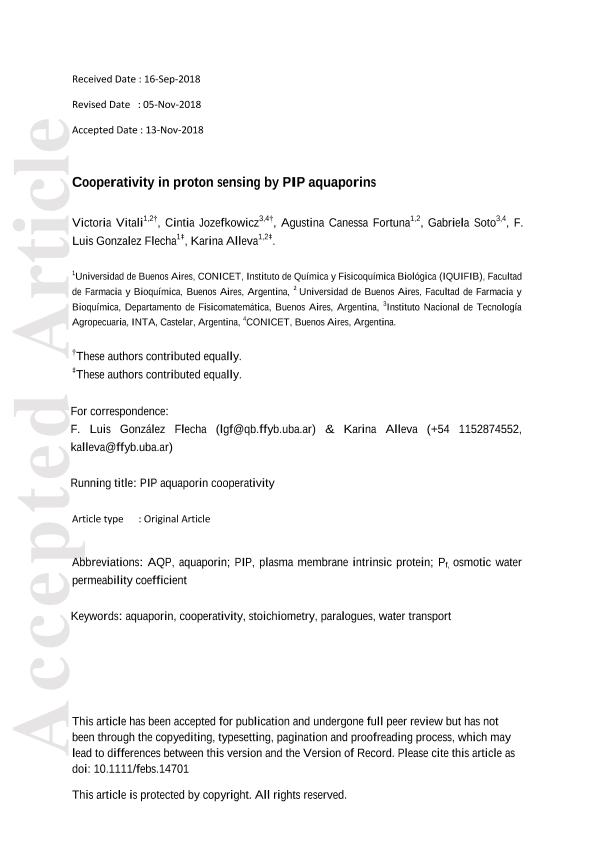Artículo
Cooperativity in proton sensing by PIP aquaporins
Vitali, Victoria Andrea ; Jozefkowicz, Cintia
; Jozefkowicz, Cintia ; Canessa Fortuna, Agustina
; Canessa Fortuna, Agustina ; Soto, Gabriela Cynthia
; Soto, Gabriela Cynthia ; Gonzalez Flecha, Francisco Luis
; Gonzalez Flecha, Francisco Luis ; Alleva, Karina Edith
; Alleva, Karina Edith
 ; Jozefkowicz, Cintia
; Jozefkowicz, Cintia ; Canessa Fortuna, Agustina
; Canessa Fortuna, Agustina ; Soto, Gabriela Cynthia
; Soto, Gabriela Cynthia ; Gonzalez Flecha, Francisco Luis
; Gonzalez Flecha, Francisco Luis ; Alleva, Karina Edith
; Alleva, Karina Edith
Fecha de publicación:
03/2019
Editorial:
Wiley Blackwell Publishing, Inc
Revista:
Febs Journal
ISSN:
1742-464X
Idioma:
Inglés
Tipo de recurso:
Artículo publicado
Clasificación temática:
Resumen
One of the most intriguing properties of plasma membrane intrinsic protein (PIP) aquaporins (AQPs) is their ability to modulate water transport by sensing different levels of intracellular pH through the assembly of homo- and heterotetrameric molecular species in the plasma membrane. In this work, using a phenomenological modeling approach, we demonstrate that cooperativity in PIP biological response cannot be directly attributed to a cooperative proton binding, as it is usually considered, since it could also be the consequence of a cooperative conformation transition between open and closed states of the channel. Moreover, our results show that, when mixed populations of homo- and heterotetrameric PIP channels are coexpressed in the plasma membrane of the same cell, the observed decrease in the degree of positive cooperativity would result from the simultaneous presence of molecular species with different levels of proton sensing. Indeed, the random mixing between different PIP paralogues as subunits in a single tetramer, plus the possibility of mixed populations of homo- and heterotetrameric PIP channels widen the spectrum of cooperative responses of a cell membrane. Our approach offers a deep understanding of cooperative transport of AQP channels, as members of a multiprotein family where the relevant proton binding sites of each member have not been clearly elucidated yet.
Palabras clave:
AQUAPORIN
,
COOPERATIVITY
,
PARALOGUES
,
STOICHIOMETRY
,
WATER TRANSPORT
Archivos asociados
Licencia
Identificadores
Colecciones
Articulos (IABIMO)
Articulos de INSTITUTO DE AGROBIOTECNOLOGIA Y BIOLOGIA MOLECULAR
Articulos de INSTITUTO DE AGROBIOTECNOLOGIA Y BIOLOGIA MOLECULAR
Articulos(IQUIFIB)
Articulos de INST.DE QUIMICA Y FISICO-QUIMICA BIOLOGICAS "PROF. ALEJANDRO C. PALADINI"
Articulos de INST.DE QUIMICA Y FISICO-QUIMICA BIOLOGICAS "PROF. ALEJANDRO C. PALADINI"
Citación
Vitali, Victoria Andrea; Jozefkowicz, Cintia; Canessa Fortuna, Agustina; Soto, Gabriela Cynthia; Gonzalez Flecha, Francisco Luis; et al.; Cooperativity in proton sensing by PIP aquaporins; Wiley Blackwell Publishing, Inc; Febs Journal; 286; 5; 3-2019; 991-1002
Compartir
Altmétricas



